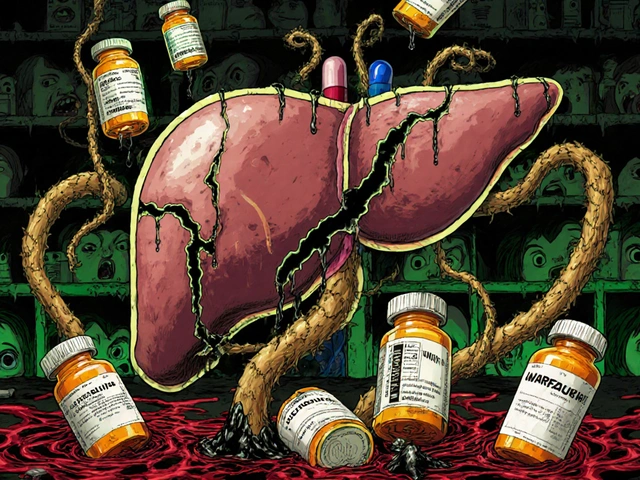When you pick up a generic pill at the pharmacy, you expect it to work just like the brand-name version. But how do regulators know it’s truly the same? The answer lies in two numbers: Cmax and AUC. These aren’t just lab jargon-they’re the core measurements that decide whether a generic drug is safe and effective enough to replace the original.
What Cmax and AUC Really Mean
Cmax stands for maximum concentration. It tells you how high the drug spikes in your bloodstream after you take it. Think of it like the peak of a rollercoaster-the highest point you reach before coming back down. If a drug needs to hit a certain level quickly to relieve pain or stop a seizure, Cmax is what matters most.
AUC, or area under the curve, measures total exposure. It’s the entire area under the graph of drug concentration over time. Imagine pouring water into a bucket and measuring how much ends up inside over several hours. That’s AUC. It shows how much of the drug your body has absorbed overall, no matter how fast or slow it came in.
For example, if you take a generic version of a blood pressure pill, the brand name might show a Cmax of 8.1 mg/L and an AUC of 124.9 mg·h/L. The generic version might show 7.6 mg/L and 112.4 mg·h/L. At first glance, those numbers look different. But regulators don’t care about exact matches-they care about whether the difference is meaningful.
The 80%-125% Rule: The Golden Standard
The U.S. FDA, the European Medicines Agency, and nearly every major health authority use the same rule: the 90% confidence interval for the ratio of generic to brand-name values must fall between 80% and 125%. That means if the brand’s AUC is 100, the generic’s must be between 80 and 125 to be approved.
This range isn’t random. It comes from decades of clinical data showing that differences smaller than 20% in total exposure or peak concentration don’t lead to noticeable changes in how well the drug works or how safe it is. The math behind it is based on logarithmic scales because drug levels in blood don’t follow a straight line-they follow a curve that’s naturally skewed. Taking the log turns it into a normal distribution, making the stats reliable.
And here’s the catch: both Cmax and AUC must pass this test. One alone isn’t enough. A drug might have the same total exposure (AUC) as the brand, but if it peaks too high or too low (Cmax), it could cause side effects or fail to work. That’s why regulators require both.
Why Both Metrics Matter: Real-World Examples
Not all drugs behave the same. Some are sensitive to how fast they enter your system. Take painkillers like ibuprofen or opioids: if the peak concentration is too low, you won’t feel relief fast enough. If it’s too high, you risk stomach bleeding or respiratory depression. That’s why Cmax is critical here.
On the other hand, drugs like statins or antidepressants work over time. Their effect depends more on how much total drug builds up in your body. For these, AUC is the key. If the AUC is too low, the drug won’t work. Too high, and you might get liver damage or muscle pain.
Narrow therapeutic index drugs-those with a tiny window between safe and toxic-are especially tricky. Warfarin (a blood thinner), levothyroxine (for thyroid), and some epilepsy drugs fall into this category. For these, even a 10% difference in exposure can cause a blood clot or a seizure. That’s why some regulators now recommend tighter limits-90% to 111%-for these specific drugs.

How Bioequivalence Studies Work
Testing isn’t done on patients. It’s done on healthy volunteers-usually 24 to 36 people. Each person takes both the brand and the generic, in random order, with a washout period in between. Blood is drawn 12 to 18 times over 24 to 72 hours, depending on how long the drug lasts.
The timing of those draws is everything. If you miss the first hour or two after taking the pill, you might not catch the true Cmax. That’s one of the most common reasons studies fail. Labs use ultra-sensitive machines-liquid chromatography with mass spectrometry (LC-MS/MS)-to measure drug levels as low as 0.1 nanograms per milliliter. That’s like finding a single grain of salt in a swimming pool.
The data goes into specialized software like Phoenix WinNonlin. The numbers are log-transformed, ratios are calculated, and confidence intervals are built. If both AUC and Cmax fall within 80%-125%, the drug is approved.
What Happens When the Numbers Don’t Match?
Not every generic passes on the first try. If a study fails, the manufacturer has to tweak the formulation-change the filler, coating, or particle size-and run it again. Sometimes, the brand-name drug itself has high variability. That means different people absorb it differently. For those cases, regulators allow something called reference-scaled bioequivalence, which adjusts the acceptance range based on how much the original drug varies between people.
This approach is used in the U.S. for drugs like cyclosporine and tacrolimus, but the European Medicines Agency is more cautious. They require extra justification. This difference in rules can delay generic approvals in some countries, even when the drug is scientifically equivalent.

Why This System Works-and Why It’s Still Needed
Before this system, companies had to run expensive clinical trials comparing how patients felt or how their disease progressed. Those studies took years and cost millions. The Cmax/AUC method cut that down to weeks and thousands of dollars.
And it works. A 2019 review of 42 studies in JAMA Internal Medicine found no meaningful difference in safety or effectiveness between generics and brand-name drugs that met bioequivalence standards. Over 1,200 generic drugs were approved in the U.S. in 2022 alone, all using this method.
Even as new technologies like computer modeling emerge, Cmax and AUC remain the gold standard. Why? Because they’ve been tested, validated, and used for over 40 years. They’re simple, measurable, and directly tied to how the body actually responds to the drug.
The Future: Are Cmax and AUC Enough?
For most pills-immediate-release, taken by mouth-yes. But for complex drugs like extended-release patches, inhalers, or injectables, a single peak and total exposure might not tell the whole story. The FDA is exploring partial AUC measurements for drugs with multiple absorption phases. For example, a slow-release pain patch might release drug in two waves. Standard AUC might look fine, but if the second wave is too late, it won’t help nighttime pain.
Still, the core idea stays the same: measure how much drug gets into the blood and how fast. Whether it’s one number or five, the goal is always the same: make sure the generic does what the brand does, without putting patients at risk.
What does Cmax stand for in bioequivalence?
Cmax stands for maximum plasma concentration-the highest level a drug reaches in your bloodstream after you take it. It tells you how fast the drug is absorbed and is especially important for drugs where timing affects effectiveness or safety, like painkillers or seizure medications.
What is AUC and why is it important?
AUC, or area under the curve, measures total drug exposure over time. It shows how much of the drug your body has absorbed from start to finish. For drugs that work gradually, like antidepressants or statins, AUC is the key indicator of whether the dose is strong enough to be effective.
Why do both Cmax and AUC need to pass for bioequivalence?
Because they measure different things. Cmax tells you how fast the drug gets into your system; AUC tells you how much you get overall. A drug could have the same total exposure (AUC) as the brand but peak too high or too low (Cmax), leading to side effects or lack of effect. Regulators require both to ensure safety and effectiveness.
What is the 80%-125% rule in bioequivalence?
It’s the range regulators use to decide if a generic drug is equivalent to the brand. The 90% confidence interval for the ratio of generic to brand values (for both AUC and Cmax) must fall between 80% and 125%. This means the generic can’t be more than 20% lower or 25% higher than the brand in terms of exposure or peak concentration.
Are there exceptions to the 80%-125% rule?
Yes. For drugs with a narrow therapeutic index-like warfarin, levothyroxine, or cyclosporine-small changes in exposure can be dangerous. Some regulators, including the EMA and FDA, allow tighter limits of 90%-111% for these drugs. Also, for drugs with high variability between individuals, regulators may use scaled bioequivalence to adjust the range based on how much the original drug varies.
Do bioequivalence studies prove a generic drug is safe?
They prove the drug behaves the same way in the body as the brand-name version. Safety is inferred from this similarity. Decades of real-world use show that generics meeting these standards are just as safe and effective. Large studies, including one in JAMA Internal Medicine, found no meaningful difference in outcomes between approved generics and brand-name drugs.






15 Comments
swatantra kumar
November 20, 2025 AT 11:29 AMMan, I love how this post breaks down Cmax and AUC like it's a cooking recipe. I mean, who knew your blood is just a bucket and the drug is water being poured in? 🤯
Brianna Groleau
November 20, 2025 AT 17:06 PMOkay but let’s be real-this whole 80%-125% rule feels like the pharmaceutical industry’s version of ‘close enough for government work.’ I get that it’s statistically sound, but when you’re the person taking warfarin and your generic gives you a nosebleed while the brand didn’t… it’s not just a number, it’s your life. And yeah, I’ve been there. I’ve cried in a pharmacy parking lot over a pill that didn’t feel right. The science says it’s fine. My body says otherwise. And sometimes, your body knows more than the lab ever will.
Rusty Thomas
November 20, 2025 AT 20:06 PMUgh. Another ‘trust the system’ post. 🙄 When I was on levothyroxine, my generic made me feel like a zombie. My doctor said ‘it’s bioequivalent’-yeah, right. Like my thyroid cares about confidence intervals. The brand cost $40. The generic was $8. I paid the $40. My life isn’t a cost-benefit analysis.
Sarah Swiatek
November 22, 2025 AT 09:00 AMIt’s funny how we treat drug absorption like it’s a math problem when it’s actually biology in chaos. People aren’t test tubes. We have different gut flora, liver enzymes, sleep cycles, stress levels, even what we ate for breakfast. The 80-125% rule is elegant, sure-but it’s also a blunt instrument. And for drugs like cyclosporine or digoxin? It’s like saying ‘if your heart rate is between 60 and 100, you’re fine’-except your heart isn’t a number on a screen. It’s a muscle that’s been pumping for 60 years, and it remembers everything.
Dave Wooldridge
November 23, 2025 AT 18:45 PMTHEY’RE LYING. You know who controls the bioequivalence studies? The drug companies themselves. The labs? Owned by Big Pharma. The regulators? Former pharma execs. They don’t want you to know that generics are often made in the same factories as the brand-but with cheaper fillers. And those fillers? They change how the pill dissolves. It’s not about the active ingredient. It’s about the binder. And no one’s testing the binders properly. Wake up.
Rebecca Cosenza
November 23, 2025 AT 22:51 PMIf it’s approved, take it. Stop being dramatic.
Pawan Jamwal
November 24, 2025 AT 19:47 PMUSA thinks it invented science. We in India make 40% of the world’s generics. You think your FDA rules are the gold standard? We’ve been making safe, cheap drugs for decades without your fancy confidence intervals. Your system is slow. Our system is real.
robert cardy solano
November 25, 2025 AT 05:49 AMMy cousin took a generic version of his seizure med. One day he had a full-on tonic-clonic in front of his kid. Turned out the generic had a different coating-slowed absorption. Cmax was 18% below. FDA said it was ‘within range.’ His kid still won’t hug him without checking his meds first. So yeah. Numbers don’t tell the whole story.
Bill Camp
November 26, 2025 AT 08:00 AMLet me guess-this post was written by someone who got a bonus for pushing generics. You know what? I don’t care if it’s 80% or 125%. If I pay $2 for a pill that doesn’t work like the $10 one, I’m not getting a bargain-I’m getting scammed. And the fact that you call this ‘science’ is why people don’t trust medicine anymore.
Lemmy Coco
November 27, 2025 AT 14:34 PMhey i just read this and wow. i never thought about how the timing of blood draws matters so much. like if you miss the first hour, you totally miss the peak. that’s wild. also, i think the log thing is cool. i always thought math was boring until now. ty for explaining it so clear. 😊
rob lafata
November 28, 2025 AT 01:02 AMOh wow. So we’re just supposed to trust that the FDA didn’t get paid off? That the lab that tested the generic wasn’t paid by the same company that makes the brand? And you’re telling me this is ‘science’? This isn’t science-it’s a confidence trick dressed in a white coat. I’ve seen the data. I’ve seen the conflicts. You’re not protecting patients. You’re protecting profits. And the people who pay? The ones who can’t afford the brand? They’re the ones who get the gamble.
Matthew McCraney
November 28, 2025 AT 17:52 PMThey’re hiding something. Why do you think the FDA lets them use ‘reference-scaled bioequivalence’? Because the brand drugs are too damn inconsistent! The original isn’t even reliable! So they’re letting generics off the hook because the brand’s own data is garbage. And you’re all just nodding along like sheep. Wake up. This isn’t about safety. It’s about control. They want you dependent on their system. And they don’t care if you bleed out from a warfarin mismatch.
serge jane
November 30, 2025 AT 02:20 AMIt’s interesting how we reduce human physiology to two numbers and call it a day. I get the practicality. I really do. But there’s something deeply human about the fact that two people can take the same pill and have completely different experiences. The science tries to standardize that. But biology doesn’t care about standards. It just is. Maybe the real question isn’t whether the numbers match-but whether we’re willing to accept that medicine will never be perfectly predictable. And that’s okay. We just need to listen more than we measure.
Nick Naylor
November 30, 2025 AT 03:08 AMLet me be clear: the 80%-125% confidence interval is not a ‘rule’-it’s a statistically validated, pharmacokinetically grounded, log-transformed, non-parametrically analyzed, FDA-validated, ICH-guideline-compliant, bioequivalence acceptance criterion. It’s not ‘close enough.’ It’s evidence-based. It’s been replicated across 12,000+ studies. You don’t get to replace peer-reviewed science with anecdotal fear-mongering. If you’re having issues, get your TDM done. Or stop blaming the system.
Cinkoon Marketing
December 1, 2025 AT 20:48 PMInteresting. But have you considered that some generics are made in the same facility as the brand? Like, literally the same line. Just different label. So maybe the whole debate is a distraction. The real issue is transparency-not the numbers.